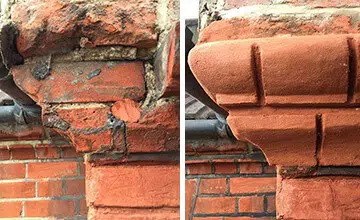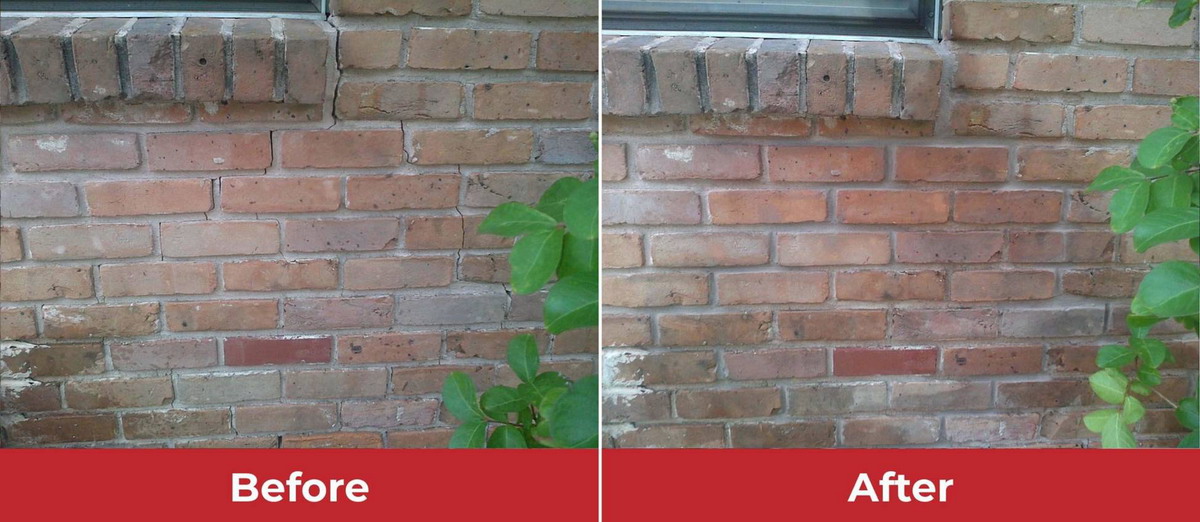What Is Brick Repair?
Brick repair is the remedial process of bringing damaged and worn-out brick back to health and back to its original condition. This is done via a wide range of masonry repair such as repairing chipped brick, frost damaged brickwork, restoring aged brick, treated decay, and much more.
What Does Brick Damage Look Like?
Bricks crumbling or flaking is commonly referred to as spalling.
A brick deteriorates when its surface flakes off over time.
You can identify brick damage by checking if the bricks are no longer flat with square edges and have become rounded and bumpy.
If your brick wall is no longer flat and uniform, it is highly likely it has experienced damage.
Our expert and friendly team can provide you with a free consultation and quotation for further insight into the current condition of your brick.
Spalling, also known as brick crumbling or flaking, is a common issue that occurs when the surface of a brick deteriorates over time.
If the edges of your bricks are no longer square and the surface has become rounded and bumpy, it is a sign of brick damage.
When your brick wall is no longer flat and uniform, it is highly probable that it has experienced damage.

What Causes Brick Damage?
Brick damage is a common occurrence that can happen over time due to the freezing and thawing cycle of moisture.
Bricks, made of clay, are porous and easily absorb water.
In the winter, the absorbed water freezes and expands, pushing small pieces of brick out of the way and causing it to crumble and break off.
This can also create small cracks in the brick.
In the summer, the melted water runs out of the brick.
With each cycle, the small cracks are filled with water, expanding and leading to larger cracks and further deterioration over time.
Brick damage is a frequent issue that occurs over time due to the freeze-thaw cycle of moisture.
Being porous, bricks made of clay absorb water easily.
In winter, the absorbed water freezes and expands, causing small pieces of brick to break off and the brick to crumble.
This may also lead to small cracks in the brick.
In summer, the melted water drains out, but the next winter cycle fills the cracks with water again, causing further expansion and deterioration.
With each cycle, the cracks get bigger, leading to even larger cracks and eventual deterioration.
How To Repair Brick Damage?
If you notice that your brick has suffered damage, the first step is to seek assistance from a professional in the industry, such as our team.
Each brick wall and type of damage requires a specific solution.
Typically, brick damage is repaired using a technique called pointing.
This involves repairing mortar joints between bricks or other masonry elements that have cracked or disintegrated due to aging.
Damaged mortar is removed by hand or power tool and replaced with fresh mortar of the same composition as the original to ensure a seamless repair.
Depending on the extent of the damage and the type of brick wall, sealing repair work may also be necessary to address leaks and prevent further damage caused by moisture.
Once you’ve identified that your brick has suffered damage, the first step is to contact an industry professional like our team.
Since each brick wall and type of damage is unique, they require a specific solution.
Generally, brick damage is repaired using the pointing technique.
This involves removing the damaged mortar between bricks or masonry elements and replacing it with fresh mortar of the same composition as the original to create a seamless repair.
However, for walls with extensive damage and leaks caused by moisture, sealing repair work may also be necessary.
Sealing brickwork is essential to prevent further damage and maintain the integrity of the wall.
How To Prevent Brick Damage?
Although brick damage is a common and normal occurrence on brick walls over time, there are certain measures which can be taken in order to prevent damage as much as possible.
Examples include.
✓ ensuring water is properly draining from around your property.
✓ checking the property for leaks.
✓ installing a snow/rain cap on your chimney.
✓ avoid pressure washing your brick work as this can weaken it.
✓ regularly inspecting your brickwork and chimney and calling a specialist if any cracks are found.
✓ addressing as soon as possible.
✓ keep crawling vines in check as they may trap moisture, and much more.


